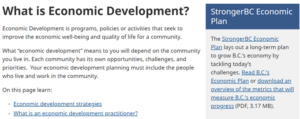Defining “Economic Development” in Statutory Law: Content and Strategy
by Brian Czech
The only way to arrive at a safe, sustainable, steady state economy is with substantial behavioral and political reform. Those two categories of reform correspond roughly with the demand side and supply side of the economy, respectively. In the simplest of terms, people must conscientiously demand less—wealthy people in particular—and policymakers must help ensure that the supply of goods and services is not in a state of overshoot.
My focus here is on the supply side. That means all economic production: agriculture, extraction, manufacturing, and services. The level of economic activity is steered to a significant extent by public policy, most obviously in socialist nations but clearly enough in capitalist democracies as well.

Growth and development are no longer compatible! (Pix4free)
I’ll focus on the USA, but the principles will apply to international politics as well. Governments around the world need to intentionally and explicitly get off the growth path and help their nations move toward a steady state economy. For the wealthier countries in an advanced state of overshoot, clearly including the USA, the goal should be degrowth toward a steady state economy.
I will argue that the place to start with policy reform is statutory law; that is, the bills hammered out in Congress and signed into law by the President. I will further argue—surprisingly to some—that the most strategic starting point is with laws propounding the phrase “economic development.” Amendatory language in the economic development laws will open the door for the big prize: divorcing the government from “economic growth.”
Economic Development in the United States Code
The United States Code (Code) is the authoritative compilation of “general and permanent” laws of the USA. Highly specific and short-term laws (amnesty laws, for example) are not included in the Code. The heart of the Code is statutory law; that is, legislation, the complete collection of which is found in the United States Statutes at Large.
The Code also includes other types of binding federal policy, such as executive orders and presidential proclamations. However, judicial case law (aka “common law”) is not included. Neither are federal agency regulations, which are codified instead in the Code of Federal Regulations (CFR).
I used to tell my Virginia Tech students to think of U.S. law and policy as falling on a spectrum from “Big P” (P for policy) to “little p” in terms of power, scope, and durability. Agency-specific regulations would typically be toward the little-p end of the spectrum, as their scope is quite limited. Executive orders—impressively powerful and sweeping—are toward the Big-P end of the spectrum. Their power tends to diminish or disappear, however, when a new president is elected.
| Title | Subject | Sections | Instances |
| 42 | The Public Health and Welfare | 93 | 166 |
| 7 | Agriculture | 52 | 70 |
| 22 | Foreign Relations and Intercourse | 41 | 48 |
| 15 | Commerce and Trade | 18 | 31 |
| 40 | Public Buildings, Property, and Works | 16 | 28 |
| 16 | Conservation | 20 | 26 |
| 49 | Transportation | 19 | 26 |
| 25 | Indians | 21 | 25 |
| 29 | Labor | 14 | 21 |
| 48 | Territories and Insular Possessions | 13 | 17 |
Top ten titles in the United States Code by instances of “economic development.”
Herein, we are concerned with statutory law, which comprises the bulk of the Code. A statute hammered out in Congress and signed by the President is powerful, sweeping, and durable (short-term laws excepted). Statutory law is the biggest “P” in the policy world. We need it for steady statesmanship.
The phrase “economic development” is used 555 times in codified, statutory law. It’s found in 27 of the 53 titles comprising the Code. The prevalence of the phrase varies substantially across those 27 titles. For example, it appears only once in Title 35 (Patents), and there, only because the Native Latex Commercialization and Economic Development Act of 1978 is cited.
In contrast, “economic development” is a predominant theme in Title 42 (Public Health and Welfare). It appears 166 times there, often as a criterion for federal grants, community planning, or the management of crucial resources such as water. The fact that it is so prominent in the title on health and welfare reflects how important economic development has been deemed by Congresses past.
Growth and Development in the Vernacular
In the vernacular, economic development is hardly discernible from economic growth. When people think of economic development, they think of more roads, facilities, houses, and businesses. That’s also growth, plain and simple. Yet the mere existence of the two phrases indicates that there is, or should be, some distinction between growth and development.
Fortunately, vernacular languages change with the times. Already, in the vernacular of certain segments of society, “development” tends to connote an improvement, a bettering, an increase in the quality of life that is not so clearly or prevalently implied by “growth.” This was a key point of a 2010 book by Daphne Greenwood and Richard Holt, Local Economic Development in the 21st Century. The subtitle gets the point across as succinctly as possible: Quality of Life and Sustainability.
An even more telling phrase is the title of their Chapter 1: “Economic Growth vs. Economic Development.” Referencing the work of Herman Daly, among others, they support the argument that growth and development are not one and the same. They elaborate extensively on the concept and process of economic development throughout the book, but their basic definition is concise: “a broadly based and sustainable increase in the overall standard of living for individuals within a community.” For Greenwood and Holt, the “standard of living” is not equated (as conventional economists often equate it) with GDP growth, either.

British Columbia is smack in the middle of a debate: Is economic development served by economic growth? (Government of British Columbia)
If only all entities would distinguish so agreeably between growth and development, we’d be in steady-state business. Unfortunately, that is far from the case. Conventional economics is still a pro-growth pursuit, and many of our economists in civil service learned their craft in the neoclassical departments of American academe.
Where the academic rubber meets the public policy road, the tendency is once again to combine growth and development into a relatively seamless concept. The mission of the U.S. Economic Development Administration (EDA), for example, is to “lead the federal economic development agenda by promoting innovation and competitiveness, preparing American regions for growth and success in the worldwide economy.” They define economic development as “Creating the conditions for economic growth and improved quality of life by expanding the capacity of individuals, businesses, and communities to maximize the use of their talents and skills to support innovation, job creation, and private investment.”
While the EDA has defined economic development, Congress has not. The EDA clearly took liberties in defining economic development in terms of growth. That gives steady staters a meaningful, feasible opportunity for some highly effective policy reform.
Strategic Relevance of “Economic Development” in Statutory Law
As it stands, the 555 references to economic development in the United States Code are interpreted by grant applicants, local governments, political appointees, bureaucrats, and judges to mean, in essence, economic growth. More roads, facilities, houses, and businesses, with no attention to optimal scale.
Imagine if all such grant applicants, local governments, political appointees et al. were to be informed, and thenceforth regularly reminded, that development and growth are not at all the same thing. To the degree the distinction was emphasized, or even mandated as a criterion for agency operations, the impetus for GDP growth would be greatly defused from the supply side.
Let’s take a crack at a statutory definition of economic development. For the steady-state purposes at hand, the definition must be a combination of delimiting (relatively exhaustive, comprehensive) and narrowing (precluding meanings that might otherwise be or become inferred):
“Economic development” means the pursuit and achievement of material, physical, and environmental conditions that improve, or are conducive to improving, the public health, safety, and welfare. It neither necessitates nor precludes economic growth, a growing population, and/or a growing GDP. Economic growth in some contexts may be conducive to economic development, and may in other contexts be preclusive of economic development. Economic development is always desirable, while economic growth may be undesirable where it causes more harm than good to public health, safety, and welfare.
Now that we have a steady-state (or at least a growth-agnostic) definition of economic development, the next question is where it should be entered into statutory law. There are two basic approaches. The first is to amend a particular statute, thereby setting a precedent that would spread across the culture of an agency and the government at large. The second approach, “going for broke” we might call it, would be an act of Congress to essentially amend the entire Code, such that any and all mentions of “economic development” in codified, statutory law hew to the new definition.
Taking the first approach, we might amend, for example, the Public Works and Economic Development Act of 1965 (PWEDA). Codified in Title 42, Section 3121 of the Code, PWEDA established the Economic Development Administration (EDA). PWEDA alone accounts for a hefty share of the “economic development” instances in the Code.1 Amending PWEDA to include the definition above would commit the EDA to a veritable paradigm shift. The agency would have to modify its mission statement and replace its small-p, growth-oriented definition of economic development with the Big-P definition mandated by Congress.
Still considering the first approach, a strategic variant would be to select a “lesser” title, in terms of its economic development prominence. For example, “economic development” is found only five times in Title 43, Public Lands. Presumably it would be a lighter lift to squeeze our paradigmatic definition into a section of the Code that is largely about conservation to start with. Entering the definition in Title 43 would have less of an effect than in Title 42, but would still set a highly helpful precedent.
The second approach, “going for broke,” would essentially define economic development for the entire federal government in one fell swoop. With this approach, there’d be no need for a precedent to spread across the culture of an agency and the government at large. The new definition would be the law of the land, immediately superseding any small-p references to economic development in the regulations and internal policies of federal agencies.
Then What?
Idealists and dreamers may shrug their shoulders and lament, “Big deal, a definition of economic development. What about all the emphasis on economic growth per se?” And they’d have a point, with 73 “binding references” to economic growth in the United States Code. Yet we have to start somewhere; we have to find traction in the terrain of public policy reform. Defining economic development would clearly be more “tractionable” than superseding economic growth at this point in the history of statutory law.

The United States Code: in need of steady statesmanship. (Wikimedia)
Such an inroad to statutory law would indeed “crack the Code” open, begging questions like, “Under what circumstances is economic growth not conducive to economic development?” Such questions would call for additional definitions of terms required for steady statesmanship. Terms like “natural capital,” “ecosystem services,” “carrying capacity,” “ecological footprint,” “biocapacity,” and perhaps the summum bonum of steady statesmanship: “optimal scale.”
Defining economic development in statutory law would make John Stuart Mill, Herman Daly, and Daphne Greenwood proud. It would be the greatest achievement to date in bringing ecological economics, steady-state economics, and degrowth principles into public policy. Furthermore, it would lower the propensity of the U.S. government to push for GDP growth, truly “by definition.”
I’d call that a major economic development.
1 PWEDA, as amended, includes 186 instances of “economic development” (capitalized in some instances). Apparently not all instances have been codified, unless perhaps some were codified outside of Title 42.
Brian Czech is CASSE’s Executive Director.





The most disruptive and wasteful policy comes from the limitless variety of goods and services. Any person or organization is allowed to market their products, many of which are disposable goods. A wise government will allow persons or organizations to market products only if the said products are beneficial for citizens’ health and least disruptive to the environment. In sum, competition would happen in the prototype phase, and consumers would only be able to buy products which proved superior to all others. Advertisers would become extinct, thankfully.
Brian, Thanks. I have been working on the same sort of thing, preferring to work on prosperity rather than growth since so much of growth harms community prosperity. I have been beating the drum for more than 20 years, but not yet sure anyone other than those into the end of growth so we can have a livable planet, have started to get it.
Perhaps changing policies and statutes requires a war of words. Brian writes: “Imagine if all such grant applicants, local governments, political appointees et al. were to be informed, and thenceforth regularly reminded, that development and growth are not at all the same thing.” I believe this can happen, but it would require peeling away many layers of resistance, both conscious (Heritage and Cato Foundations, the donor class, etc.) and unwitting (media, academia, etc.) “Development and growth are not the same thing” needs to become a public mantra. This looks like a phrase in need of a counterculture movement.
This is an outstanding proposal, Brian — concrete, comprehensible, and (possibly) even achievable. Something worth working for.
Growth as a measure of public resources & intervention needs to become defined by its NET benefits for a defined area, in the form of community well-being gains. Govt at all levels is limited to programs, projects, & initiatives: no one in govt has any real knowledge or experience in our CED ( Community Economic Development) field, using PUBLIC resources. We are in a no-win situation.
In private sector terms, where are the public sector’s “profits” from the “investment” of public resources?
An “emphasis on economic growth per se” ought not to be a problem. I am an Ecological Economist who advocates a steady-state economy. I also support ‘economic growth’, where growth in GDP is genuinely ‘economic’ (increases benefits more than it increases costs). I’m opposed to ‘uneconomic growth’ (increases costs more than it increases benefits). I haven’t equated the growth in GDP with economic growth for around 25 years. And I refuse to do so, including in all my writings, where, on occasions, a reviewer has suggested I do so because it’s what most people do. Well, it’s time to change the way people view GDP growth, and more particularly, ‘economic growth’.
If economic growth is redefined as GDP growth that increases benefits more than it increases costs, and uneconomic growth as GDP growth that does the opposite, and this was stated explicitly in the U.S. Code, there would be no need to remove the term ‘economic growth’. It would mean that policy makers would have to look for an indicator other than GDP to assess the likely impact of their policies. Where might they look? There is a thing called a Genuine Progress Indicator (GPI) that counts the benefits and costs of the economic process. Hence, an appropriate change to the U.S. Code would operationalise the GPI. At long last!
Having said the above, I think it would be better to replace ‘economic growth’ in the U.S. Code with ‘economic development’, where the latter would be defined much as Brian has defined it but where “the pursuit and achievement of material, physical, and environmental conditions” might entail GDP growth but might entail welfare-increasing capital replacement (maintenance of the steady-state). Economic growth would be subsumed by economic development in cases where GDP growth was genuinely ‘economic’ (increased the GPI). Instances of uneconomic growth would be rejected (reduced the GPI).
Yes, Phil (and as we’ve discussed over the years), those are indeed the two paradigm-shifting, definitional alternatives: 1) recognizing GDP as the measure of economic growth (as in the amount or level of economic activity, good and bad alike), but then emphasizing that GDP must at some point exceed optimal and even sustainable scale, even while we are still calling it economic growth, as conventional economists and policy makers would, or; 2) pitching the meaning of “economic” as causing more benefit than harm, by definition, thereby delineating economic growth as something necessarily good and appropriate.
Herman Daly used to tease out the latter usage (as one of my links reminded readers), yet even Herman didn’t push it too hard, because he agreed that the first meaning of economic growth (increasing production and consumption of goods and services in the aggregate, entailing a growing population × per capita consumption, measured with GDP) is entirely ensconced, and frankly is perfectly meaningful. So, with this first approach, we simply recognize that growth is good for some time, reaches optimal scale, and exceeds optimal scale (and eventually even ecological capacity.) That is the approach we are committed to at CASSE, while still recognizing and reminding readers occasionally of what we might consider the second definition of “economic growth” (more benefit than harm) in our steady-state dictionary.
Firm agreement with you on using GPI (along with a number of other metrics) to help us ascertain optimal scale, too.
And for assessing the environmental impact of growth, the single best indicator is probably… GDP itself!
https://steadystate.org/using-gdp-to-estimate-the-limits-to-growth/
Thanks Phil for the great steady-state economics, as always.
Further to my previous comment, an economic limit to growth – when GDP growth becomes uneconomic – is reached prior to the ecological limit to growth (where the throughput required to maintain the larger GDP exceeds the ecosphere’s regenerative and waste assimilative capacities). Thus, it can be assumed that if GDP growth is presently ‘economic’, the physical scale of the larger GDP is also ecologically sustainable.
Excellent idea. I like the idea of strategy 1b – title 43 Public Lands – as a way of testing the waters.
Question: does the wording need to provide a metric for public health, safety, and welfare, to prevent government entities from defaulting to GDP, which they already think they know how to measure? Best of all would be if the explicit metric were something that the government does already measure.
This seems like a good start Brian.
But I think the definition needs something more, as I have added here . . .
“Economic development” means the pursuit and achievement of material, physical, and environmental conditions that improve, or are conducive to improving, the public health, safety, and welfare, while not restricting or limiting personal freedoms or the right to express opinions.
I do not wish to trade my personal freedoms for a better physical standard of living.
OK Barry, but “personal freedoms” including “the right to express opinions” are already protected by the biggest P in the policy arena: the Constitution and in particular the Bill of Rights (which is technically classified as a special category of statutory law). Nothing in the proposed definition of “economic development” could be seen as repealing or superseding those rights. Therefore, the Office of the Law Revision Counsel (in charge of maintaining the U.S. Code) would never codify the additional phrase you suggest. It goes without saying and would be deemed too redundant.
That said, you can’t scurrilously yell “FIRE!” in a crowded theater, and you can’t constitutionally incite an insurrection. If you’re Big Tobacco, you can’t advertise your product as non-carcinogenic. Big Oil can’t be allowed to deny the climate-forcing properties of greenhouse gas emissions.
In my opinion, it ought to be severely frowned upon—if not outright illegal—to fallaciously frame “economic growth” as congruent with environmental protection, and/or perpetually desirable. The win-win rhetoric is a huge political lie that threatens the health, safety, and welfare of present and future generations.
The qualities of being congruent with environmental protection and perpetually desirable, at least in a macroeconomic context, ought to be reserved for the phrase “economic development.” Defining the term properly in statutory law would accomplish that.
I respond to the issue of personal freedom. I believe that a society that consumes less and more meaningfully, will produce more freedom. I use the Dutch as an example. They have restricted the freedom of car drivers to go anywhere they please, but this in the name of freedom, because in the 1950s Dutch car culture, the freedom of pedestrians and bicyclers was trampled on because of unbridled car freedom. In other words, sharing of public space may appear to constrain one person’s freedom but enhance the general freedom of the majority, and in fact, provide clean air for all people, including car drivers. One fundamental freedom is to breathe clean air. In the USA, fossil fuel use per capita is 64,000 kWh, whereas in Europe, where “freedom to drive a car” is constrained by pricing and use of space, per capita use of fossil fuels is 29,000 kWh. At a personal level, I am convinced that there are ways (call it degrowth) for people to consume less and yet improve their overall freedom. I’ve lived in Europe for 1/3 of my life. I never felt that consuming less was an infringement to my freedoms.
Hello Brian,
Thank you for your very interesting proposal outlined in the latest CASSE newsletter.
This recent US Economic Development Agency (USEDA) bulletin (https://content.govdelivery.com/accounts/USEDA/bulletins/36ea272) is worth following if you’re not already subscribed to it. It’s fascinating to identify the hidden “growth doctrine” embedded in federal-level economic development policy and practice in USEDA’s posts.
Note, especially, the frenzied tech hub incentive application process that is driving housing prices even farther into the stratosphere in already-expensive, limited-supply housing markets like here in Boulder, CO.
And yet, almost no elected officials purporting to deal with the fallout from corporate-serving, behind-the-backs-of-voters economic development incentives have been able to connect the dots between the worsening housing crisis brush fire wars they keep fighting and the deep flaws in economic development engines’ undemocratic, lacking-in-oversight, ecologically-illiterate policies and practices that are embedded in all levels of government as taken-for-granted public-private partnerships.
Brian, In relation to the supply side, its correct…’policymakers must help ensure that the supply of goods and services is not in a state of overshoot.’
Adjusting the language and meaning of the policy direction is an extremely worthy goal. Such definitions set the mission statement for govt direction. Policy has taken us away from the polluting cities of the industrial revolution to the net zero targets of 2050.
Its worrying to see Rishi Sunak row back on environment policy commitments stating GDP growth must be prioritised.
With global instability currently clear to be seen, P.M.s like Rishi may be more inclined to protect jobs – strengthen economies and set aside surplus for the defence of the nation.
Govt policy for me roughly equates, not to the supply side, only to the policing of the supply side. The supply side is mostly privately owned businesses, motivated to act to make legal gains.
Simply put, unregulated, it is perfectly rational to chop down the last tree before someone else gets to it before you.
The profit seeking sector, locked in competition for survival, is by its nature, bad for nature.
Somehow the profit seeking sector needs to be largely replaced with not for profits, which compete to deliver our needs for well lived sustainable lives.
In this scenario, consumers, government, and business can all be on the one team assisting together to protect our world. Govt no longer policing with policy, taking on the role of The Coach.
As Ole Gunnar Solskar, Manchester Uniteds former coach laments…”you need everyone to pull in the same direction,”